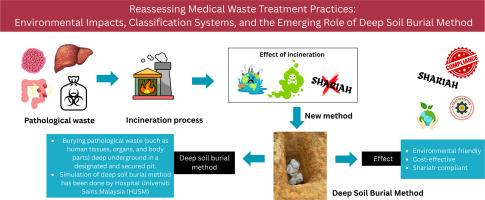环境可持续处置病理废物:评估在马来西亚深土掩埋法
Q2 Environmental Science
引用次数: 0
摘要
医疗废物数量不断增加,在世界范围内对环境、公共卫生和文化构成重大挑战。焚烧、高压灭菌和堆填等传统处置方法被广泛采用,但仍受到成本高、有毒物质排放、能源需求和监管限制的制约。在马来西亚,这些问题由于有限的治疗基础设施和宗教敏感性,特别是在病理性废物的管理方面,而变得更加复杂。本综述严格评价了现有的医疗废物处理技术及其社会环境影响,同时介绍了深土掩埋作为一种可行的替代方法。该方法自2018年起在马来西亚巴加尔大学医院实施,涉及将病理废物埋在具有分层土壤覆盖的工程坑中,进行福尔马林分离和埋后现场监测。有证据表明,这种方法具有成本效益,对环境安全,并符合监管框架和伊斯兰教法原则。因此,对于缺乏集中式生物医学废物处理设施的资源有限的环境,深土掩埋是一种可扩展的、适合具体情况的解决方案。它在马来西亚取得的成功强调了政策整合、国际上对其可持续性潜力的认可以及进一步研究以改进技术和评估长期生态影响的必要性。本文章由计算机程序翻译,如有差异,请以英文原文为准。

Environmentally sustainable disposal of pathological waste: Evaluating the deep soil burial method in Malaysia
The escalating volume of medical waste poses significant environmental, public health and cultural challenges worldwide. Conventional disposal methods including incineration, autoclaving and landfilling are widely employed but remain constrained by high costs, toxic emissions, energy demands and regulatory limitations. In Malaysia, these issues are compounded by limited treatment infrastructure and religious sensitivities, particularly in the management of pathological waste. This review critically evaluates existing medical waste treatment technologies and their socio-environmental implications, while introducing deep soil burial as a viable alternative. Implemented at Hospital Pakar Universiti Sains Malaysia since 2018, the method involves the burial of pathological waste in engineered pits with layered soil coverage, formalin separation and post-burial site monitoring. Evidence demonstrates that this approach is cost-effective, environmentally safe and compliant with both regulatory frameworks and Shariah principles. Deep soil burial thus represents a scalable, context-appropriate solution for resource-limited settings where centralized biomedical waste facilities are absent. Its demonstrated success in Malaysia underscores the need for policy integration, international recognition of its sustainability potential and further research to refine techniques and assess long-term ecological impacts.
求助全文
通过发布文献求助,成功后即可免费获取论文全文。
去求助
来源期刊

Environmental Challenges
Environmental Science-Environmental Engineering
CiteScore
8.00
自引率
0.00%
发文量
249
审稿时长
8 weeks
 求助内容:
求助内容: 应助结果提醒方式:
应助结果提醒方式:


